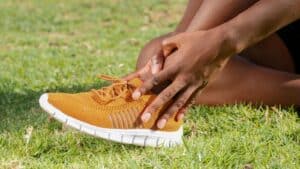Are you an avid trail runner, or perhaps you’re considering venturing into the world of trail running? It’s an exhilarating and physically demanding sport that offers the thrill of exploring nature in a unique way. But, like any physical activity, trail running comes with its fair share of challenges, particularly when it comes to injuries. In this comprehensive guide, we’ll delve into common trail running injuries and ailments, explore how to prevent them, and discuss effective treatment strategies. So, lace up your trail running shoes, and let’s hit the path!
Understanding Trail Running
Before we jump into the world of common trail running injuries, let’s take a moment to understand what trail running is and why so many people are drawn to it.
What Is Trail Running?

Trail running involves traversing natural, unpaved trails and paths, often through forests, mountains, and other scenic landscapes. It’s an adventure that offers a unique connection with nature and an escape from the concrete jungle. The uneven terrain, steep inclines, and technical terrain make trail running a distinct experience from road running.
The Appeal of Trail Running
Trail running enthusiasts are drawn to the sport for various reasons. It provides a change of scenery, a connection to nature, and an escape from the monotony of road running. However, it’s essential to acknowledge that running on uneven terrain presents its own set of challenges, including the potential for injuries.
Common Trail Running Injuries

Trail running is physically demanding, and as a result, many trail runners suffer from a range of common injuries. Let’s take a closer look at these ailments and their impact on trail runners.
1. Ankle Sprains in Trail Running
Ankle sprains are one of the most frequent injuries among trail runners. The uneven surfaces and technical terrain can lead to missteps and twisted ankles. The immediate pain and swelling may slow you down, but there are ways to prevent and treat ankle sprains.
2. Shin Splints
Shin splints, medically known as medial tibial stress syndrome, can be a painful condition for trail runners. The repetitive stress on the lower leg muscles, especially on uneven terrain, can lead to discomfort. Understanding the causes and prevention methods can help you keep shin splints at bay.
3. Overuse Injuries in Trail Runners
Overuse injuries are common among runners, and trail runners are no exception. The repeated impact on different muscles and small bones in the feet and legs can lead to issues like stress fractures, plantar fasciitis, and Achilles tendinitis. Learning to recognize the signs and prevent overuse injuries is crucial for your long-term trail running journey.
4. Impact of Trail Running on Knees
The impact of trail running, especially when running downhill or on steep inclines, can take a toll on your knees. We’ll explore how to protect your knees and maintain proper form during your runs.
Prevention Strategies

While it’s impossible to completely eliminate the risk of injury, there are several strategies that can help you avoid common trail running injuries and discomfort. Here are some essential rail running safety tips to keep you on the trails and injury-free:
Proper Footwear: One of the key factors in preventing trail running injuries is selecting the right trail running shoes. These specialized shoes offer more support and traction, reducing the risk of slipping or twisting an ankle.
Muscles Loose and Warm Up: Before hitting the trails, make sure your muscles are warm and ready for action. A proper warm-up routine can help prevent sudden muscle strains or sprains.
Paying Attention to Your Body: Listen to your body and be aware of any discomfort. If you feel pain or notice an issue, address it promptly rather than pushing through the pain, which could lead to more severe injuries.
Avoiding Overuse: Overuse injuries can be prevented by gradually increasing your mileage and allowing for rest days in between your runs. This will give your body time to recover.
Proper Form: Maintaining proper running form is crucial in reducing the risk of injury. This includes running with a shorter stride on steep downhills and maintaining a strong core to protect your lower back.
Recognizing the Signs
Injury prevention also involves recognizing the early signs of discomfort. If you experience any of the following symptoms, it’s essential to address them promptly:
- Pain: If you feel pain, especially in your feet, legs, or ankles, it’s a sign that something may be wrong.
- Swelling: Swelling in any affected area, such as the ankles or shins, should not be ignored.
- Reduced Range of Motion: If you notice a decrease in your ability to move a specific joint or body part, it’s time to investigate the issue.
First Aid and Self-Treatment

Knowing basic first-aid techniques for common trail running injuries can make a significant difference in your recovery. Here are some first-aid tips to keep in mind:
For Ankle Sprains:
- RICE (Rest, Ice, Compression, Elevation) is the standard approach. Rest your injured ankle, apply ice, use compression, and keep it elevated.
- Consider using an ankle brace or support bandage to stabilize the joint.
For Shin Splints:
- Rest and give your legs time to recover.
- Stretch and massage the affected area to relieve tension.
For Overuse Injuries:
- Reduce your mileage and intensity.
- Consult a healthcare professional for proper diagnosis and treatment options.
Recovery and Rehabilitation
In the unfortunate event that you do sustain a trail running injury, the recovery process is essential. Here’s what you can do to facilitate healing:
For Stress Fractures and Overuse Injuries:
- Complete rest is often necessary.
- Physical therapy may be recommended to rebuild strength and flexibility in the affected area.
For Ankle Sprains:
- Rehabilitation exercises are crucial to regain stability and prevent future sprains.
For Shin Splints:
- Rest and targeted exercises can help alleviate the pain.
Common Trail Running Ailments: A Closer Look
While we’ve covered some of the most common injuries in the previous section, let’s delve deeper into other ailments that trail runners might encounter during their journeys.
Plantar Fasciitis

Plantar fasciitis is a condition characterized by inflammation of the plantar fascia, a thick band of tissue that runs along the bottom of the foot. Trail runners can experience this painful ailment, especially when their arches are not adequately supported. The discomfort is often felt as a sharp, stabbing pain in the heel. To treat it, stretching and rolling a tennis ball under the foot can provide relief. Proper footwear with arch support is crucial to prevent and manage plantar fasciitis.
Achilles Tendon Strain
The Achilles tendon, a thick band of tissue connecting the calf muscle to the heel bone, can become strained or inflamed due to overuse or improper footwear. Symptoms include pain and stiffness around the back of the heel. Treating Achilles tendon discomfort involves rest, ice, and gentle stretching exercises. Gradually returning to your trail runs and maintaining proper form are essential for a full recovery.
Calf Muscle Cramps
Calf muscle cramps, while generally minor injuries, can be excruciating during a trail run. Dehydration and inadequate stretching can often trigger these painful contractions. To alleviate discomfort, gently massage the affected muscle and increase your fluid intake. Wearing proper trail running shoes that provide adequate support can also help prevent calf muscle cramps.
Treating Trail Running Discomfort: Tips for Recovery
When you do experience discomfort or minor injuries while trail running, it’s essential to know how to treat them effectively. Here are some tips for addressing discomfort and minor injuries:
Blood Flow and Recovery
Promoting good blood flow to the affected area can significantly speed up the recovery process. Consider applying heat or engaging in gentle massage to improve circulation. Blood flow aids in the delivery of essential nutrients and oxygen to the injured tissues, accelerating healing.
Outer Thigh Discomfort
Discomfort in the outer thigh, often related to iliotibial band syndrome (ITBS), can affect trail runners. To alleviate this pain, use a foam roller to gently release tension in the IT band. Ensure your running form is consistent, and consider wearing a knee strap to reduce friction over the IT band.
Wearing the Right Shoes
Proper footwear is a cornerstone of injury prevention and comfort during your trail runs. Choose trail running shoes that offer adequate support, stability, and protection. Ensure your shoes have a good grip to prevent slips and falls on uneven terrain.
Overuse Injury Management
Overuse injuries, like stress fractures, require time to heal. Listen to your body and allow complete rest during the recovery period. As the pain subsides, gradually increase your mileage and intensity to avoid further injuries.
Trail Running Safety Tips: Enjoy Your Runs with Peace of Mind
While we’ve discussed common trail running injuries and how to manage discomfort, let’s focus on safety tips to ensure you have a safe and enjoyable trail run.
Stay Hydrated
Proper hydration is crucial to prevent cramps and heat-related issues during your runs. Carry a water bottle or hydration pack and drink regularly to maintain your fluid balance. On longer trail runs, plan your routes around water sources or bring a water purification method to stay hydrated.
Listen to Your Hip Flexors
Your hip flexors play a significant role in maintaining a strong and stable core while running. Weak hip flexors can lead to poor form and even injuries. Include hip flexor-strengthening exercises in your routine to enhance stability and prevent discomfort.
Mix in Road Running
If you’re new to trail running, it’s advisable to start gradually and mix in some road running. Road running allows your body to adapt to the repetitive stress and impact, reducing the risk of overuse injuries.
Proper Diagnosis for Persistent Pain
If discomfort persists and does not improve with rest and self-treatment, seek professional medical advice. A healthcare provider can provide a proper diagnosis and recommend tailored treatment options.
Final Thoughts
Trail running is a rewarding and invigorating sport that allows you to connect with nature in a unique way. However, it’s crucial to be aware of the common trail running injuries and take steps to prevent them. By understanding the causes, recognizing the signs, and following prevention and treatment strategies, you can continue to enjoy the trails while staying injury-free.
